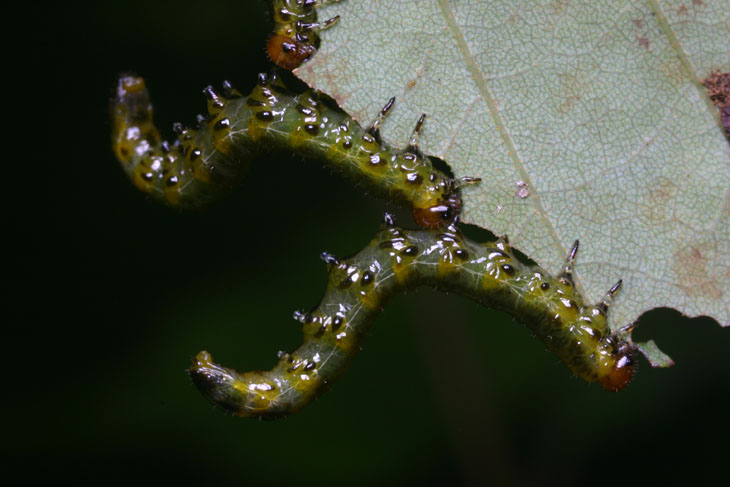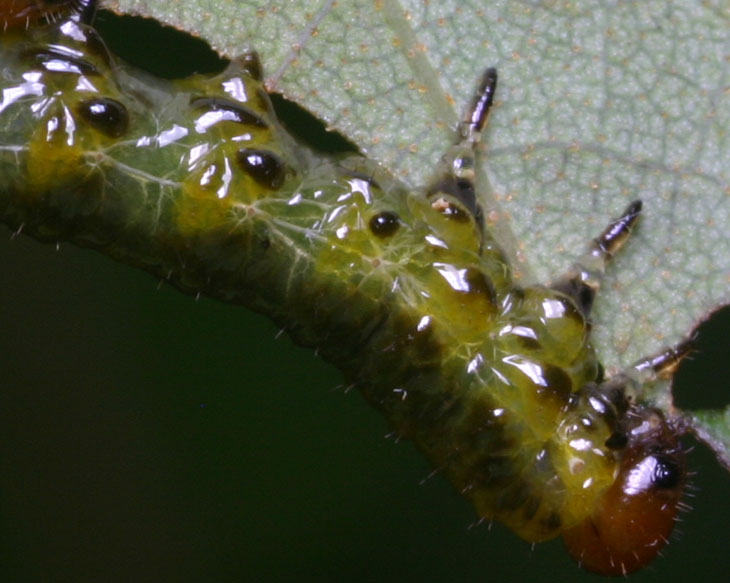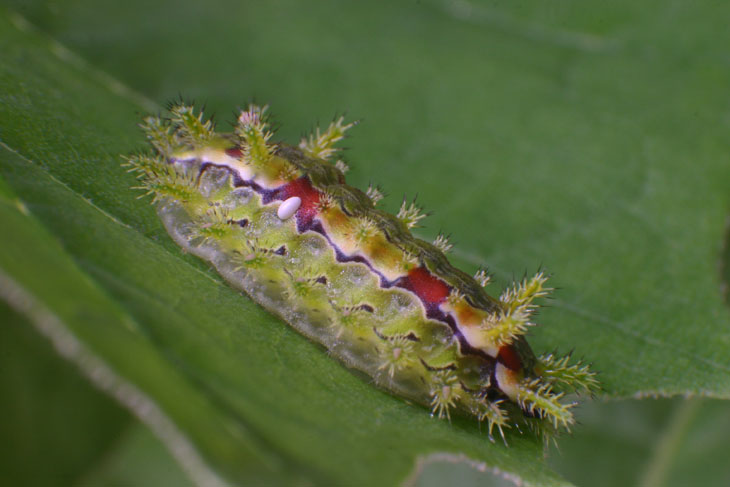
Down at the park the other day, chasing whatever I happened to come across, I did a few casual photos of unknown insect larvae, roughly 15mm in length, doing their best at denuding a small tree. Upon returning and unloading the memory card, I realized I’d caught some details I never expected to see, and certainly didn’t realize at the time, or I would’ve gotten a lot more images (and used a lens that provided for even closer work.)
Arthropods don’t breathe like we do, through a nose or mouth. They’re a little more direct, actually, and incidentally stand no chance of choking on their food. Along the sides of their bodies are small holes, called spiracles, which feed directly into tracheae that branch off and feed the tissues directly, or very close to it. These openings are subtle and hard to spot on most species, but if you see a line of spots or bumps periodically situated along the side of the body, you may be seeing them. In this particular case, however, I caught what was going on beneath the skin:

This is an almost full-resolution crop of the image at top, and the white lines branching all over are not markings, but internal anatomy. Those are the tracheae, and the brown spots at the intersections are the spiracles. This was, alas, the best image I got. While I returned to the park and collected a few specimens after seeing this pic, I did not immediately set up my studio, and by the time I did the effect wasn’t half as visible. I speculated that I was able to photograph this initially because the larvae were stuffing themselves blind on the leaves at the time, while a friend suspected this may have been immediately after molting and thus their exoskeletons were still transitioning. I also returned a few days later, ready to do more location shooting to see if that made a difference, but they were nowhere to be seen by that time. I haven’t been able to positively identify these yet, but my best guess is that they’re a member of the Argidae (sawfly) family.
Finds like this make you pay more attention to other images as well, so I noticed an odd spiracle pattern (I think) in another image while sorting my stock, taken without flash on a day with light overcast so I was shooting with the aperture wide open.

The green band, which assists in the camouflage of this larva very well, gives every appearance of having been jammed in among the line of spiracles, displacing them. Normally such cloaking patterns are just that, superficial coloration that reflects nothing anatomical, but here it almost seems to imply something deeper going on – though the spots near the borders may just be coloration. This one is identified, the larva of a unicorn caterpillar moth (Schizura unicornis,) and the peculiar spiracles are perhaps the only reason I might not toss this image, since it could be far better.
 While I was poking around the park trying unsuccessfully to locate the translucent caterpillars, I still took the opportunity to gather other images as well. We return now to days from the dim recesses of time, insofar as the blog is concerned anyway, and a post regarding the charmingly-named spiny oak-slug moth (Euclea delphinii.) I remarked then that my example images, working very well as camouflage, nevertheless reflected much less flamboyant coloration than most other pics I’d come across while trying to identify it. I haven’t spotted any other examples of this species (though admittedly may have passed quite a few of them without noticing.) Until now.
While I was poking around the park trying unsuccessfully to locate the translucent caterpillars, I still took the opportunity to gather other images as well. We return now to days from the dim recesses of time, insofar as the blog is concerned anyway, and a post regarding the charmingly-named spiny oak-slug moth (Euclea delphinii.) I remarked then that my example images, working very well as camouflage, nevertheless reflected much less flamboyant coloration than most other pics I’d come across while trying to identify it. I haven’t spotted any other examples of this species (though admittedly may have passed quite a few of them without noticing.) Until now.

As almost always, such bright colors aren’t an indication that it was intended for kids, but instead to make it memorable to potential predators, because it has a defensive response, in this case stinging (though I do not have firsthand experience of this – I can learn as well as any insectivorous bird.) This example was a little larger than the licheny one above, and it started me wondering if the bright coloration developed only after the larvae has found enough of whatever food source provides their defensive toxin. While trying to find if my speculation had any merit, I discovered that, since that previous post, there is now some hesitation among entomologists in naming a distinct species, since the adult Euclea delphinii is almost identical to the adult Euclea nanina, and the larvae are presumed to be as similar. I could have collected the specimen, raised it through pupation to adult, and made myself famous as the guy who resolved that burning question. As always, these turning points in my life are recognized only after they’ve passed…
And yes, that white spot that you see isn’t part of the larva, but something else – egg or parasitic mite, perhaps. This was another thing I missed until unloading the images. I should probably just bag everything I see anymore.




















































